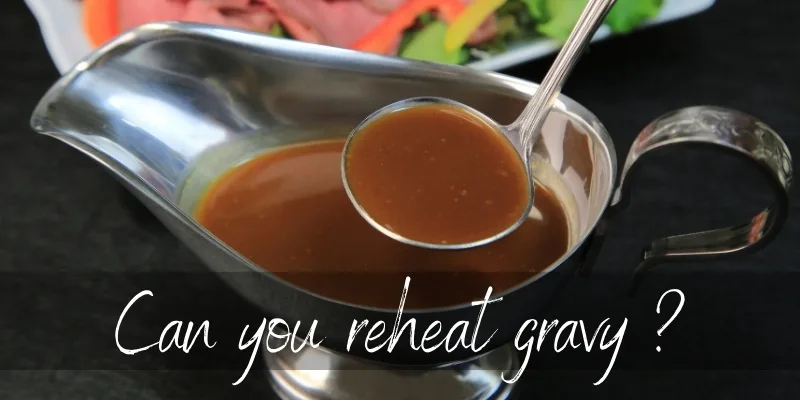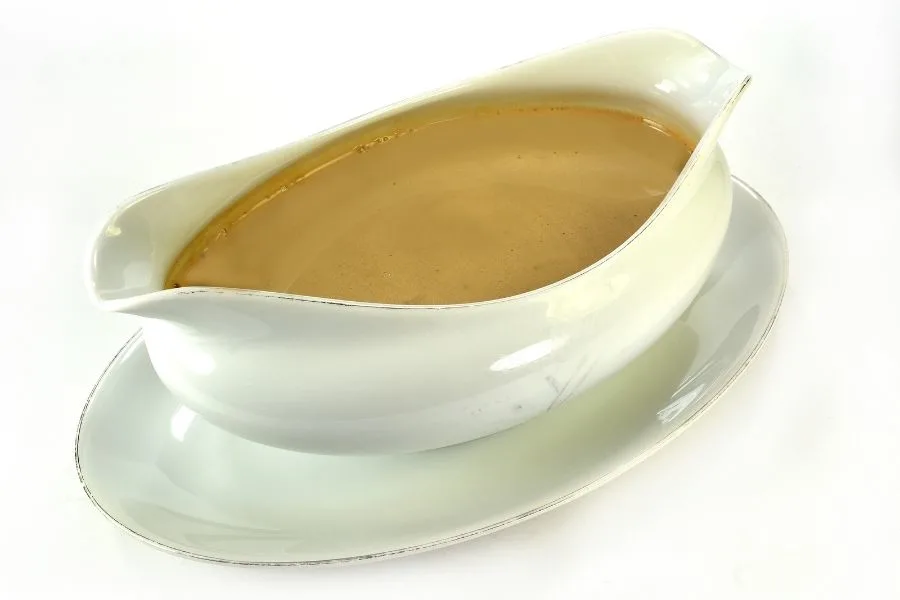Gravy is probably one of the best Thanksgiving leftovers, and we’ll tell you why. It goes great on everything, you can freeze some for later and pop it out for some amazing fries, and it’s great as a sauce on a sandwich or burger ! It can even be the base for a really delicious stew, right ?
But all of these beg the question: can you reheat gravy ? If yes, will the texture be affected ? Is there anything special you need to be aware of ? And why is next-day gravy so jiggly ? Let’s take a look.

Can you reheat gravy ?
Yes, you can easily reheat gravy and the texture will be just like the first day. Remember to start with low heat and constantly stir, otherwise you risk uneven heating or even burning the sauce in some places.
Depending on the gravy, it may be easy to use cold, for example as a cold sauce in a burger or sauce, or even as a salad dressing if you’re feeling adventurous. But if you’re looking to reheat it there are two good options. Here they are.
1. Reheat gravy in the microwave on medium heat
The simplest and quickest option is to use a microwave to reheat the gravy. Be sure to use medium or medium-low heat, and stop to stir every now and then. A microwave is likely to give you uneven heating, so stirring is a must.
Read also: Can You Reheat Spinach ?
How long you reheat the gravy is up to you, but most people would like it very hot. Stirring is also a great way to re-emulsify a gravy that’s started separating. In a worst case scenario, if it’s too separated, you can try whisking it thoroughly.
2. Reheat gravy on the stove on a low flame
Your other option is to reheat the gravy on the stove, on a low flame, stirring constantly. If you’ve left the gravy in the pan you originally made it in, then the stove is your best choice.
Make sure to use a low flame and keep stirring until it’s simmering. If your pan doesn’t have a thick bottom you risk burning the gravy. So keep whisking it, even if it’s extra-jelly and doesn’t easily melt. Run a knife through it to cube it up if you have to.
How many times can you heat up gravy ?
We recommend reheating gravy only once after it’s been cooked, as the constant cooling and heating and cooling again provides bacteria and mold opportunities to spread.
If it’s the second time you’ve reheated the gravy, make sure you brought it to a boil for about 3 minutes to kill off bacteria. Be very very sure to constantly stir in this case !
Why is my gravy jiggly ?
Gravy can get jiggly when you’ve roasted the meat, along with the bones, for a very long time and drew out a lot of gelatin. Bones, marrow, and skin contain a lot of collagen, which turns to gelatin when simmered for hours on end and then left to cool. In the case of a good roast that’s exactly what you do.
And the best way to break down gelatin is to bring it back to its liquid state, which means subjecting it to a low but constant heat. SO once your reheat your gravy, it should turn back to liquid.
You’ve likely added some starch in the form of cornstarch or flour, so it’s a bit harder to break down than regular gelatin. Still, it should be doable. Remember to use use a whisk to re-emulsify the gravy, or an immersion blender if it really needs help.

Can you keep leftover gravy ?
Yes, you can keep leftover gravy to reuse at a later date. The best way to keep leftover gravy is in the fridge, at a low temperature. Do not leave it out overnight, as bacteria and mold have a higher chance of developing at temperatures higher than 40 F/5 C.
You may notice leftover gravy developing a sort of skin as it cools down. To avoid that you can use some plastic wrap so it touches the surface of the gravy. This way, as it cools, there won’t be any air contact so no skin will form. Even if it does form, there’s nothing wrong with it, it’s just a little thicker than the rest of the gravy.
How long does gravy last in the fridge ?
Gravy can keep up to 3 days in the fridge, but it will start to separate after the second day or so. So you may need to whisk or stir it thoroughly whenever you reheat it. Be sure to use an airtight container to make sure there is no cross contamination and it doesn’t leave a smell in all the fridge.
Read Also: Can You Reheat Lasagne ?
Can you freeze gravy ?
You can also freeze gravy, in which case we recommend portioning it into smaller servings. Use small freezer-safe bags or you may even use ice cubes baggies. This way you can use small amounts if that’s all you need, whenever you need them.
Frozen gravy will likely split when it thaws, so make sure to whisk it really well when you reheat it. Don’t keep it in the freeze for more than 3 months though. After a while it starts to get that freezer flavor, and it’s never a good thing.
So in short, you can easily reheat the fruits of your labor. Especially if you’ve made a big batch of gravy and have some leftovers, storing and reheating gravy is a breeze. The biggest step is making the gravy in the first place.

